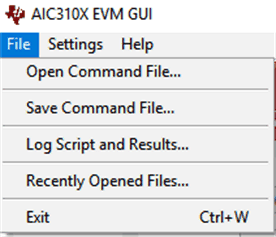SLAU855A June 2021 – March 2022 TLV320AIC3101 , TLV320AIC3104 , TLV320AIC3104-Q1 , TLV320AIC3105 , TLV320AIC3106 , TLV320AIC3106-Q1 , TLV320AIC3107 , TLV320AIC3109-Q1 , TLV320AIC34
2.4 Command Line Interface Tab
A simple scripting language controls the processor on the USB-MODEVM or AC-MODEVM from the LabView®-based PC software. The main program controls throughout the control software do nothing more than write a script that is then handed off to an interpreter that sends the appropriate data to the correct USB endpoint. Because this system is script-based, a provision is made in this tab (Figure 2-4) for the user to view the scripting commands created when the controls are manipulated, as well as load and execute other scripts that are written and saved. This design allows the software to be used as a quick test tool or to help provide troubleshooting information in the rare event that the user encounters a problem with this EVM.
A script is loaded into the command buffer, either by operating the controls on the other tabs or by loading a script file. When executed, the return packets of data that result from each command are displayed in the Read Data array control. When executing several commands, the read data control shows only the results of the last command. To see the results after every executed command, use the logging function described in this section.
The file menu (Figure 2-5) provides some options for working with scripts. The first option, Open Command File..., loads a command file script into the command buffer. This script can then be executed by pressing the Execute Command Buffer button. The second option, Save Command File, allows the user to save a script from the command line interface. The saved commands are then saved as a text file in a location specified by the user.
The third option is Log Script and Results..., which opens a file save dialog box. Choose a location for a log file to be written using this file save dialog. When the Execute Command Buffer button is pressed, the script runs and the script, along with the resulting data read back during the script, is saved to the file specified. The log file is a standard text file that can be opened with any text editor, and looks much like the source script file, but with the additional information of the result of each script command executed.
The fourth menu item is a submenu of Recently Opened Files. This option is simply a list of script files that have previously been opened, allowing fast access to commonly used script files. The final menu item is Exit, which terminates the TLV320AIC310xEVM control software.
 Figure 2-5 File Menu
Figure 2-5 File MenuUnder the Help menu is an About... menu item that displays information about the TLV320AIC310xEVM control software.